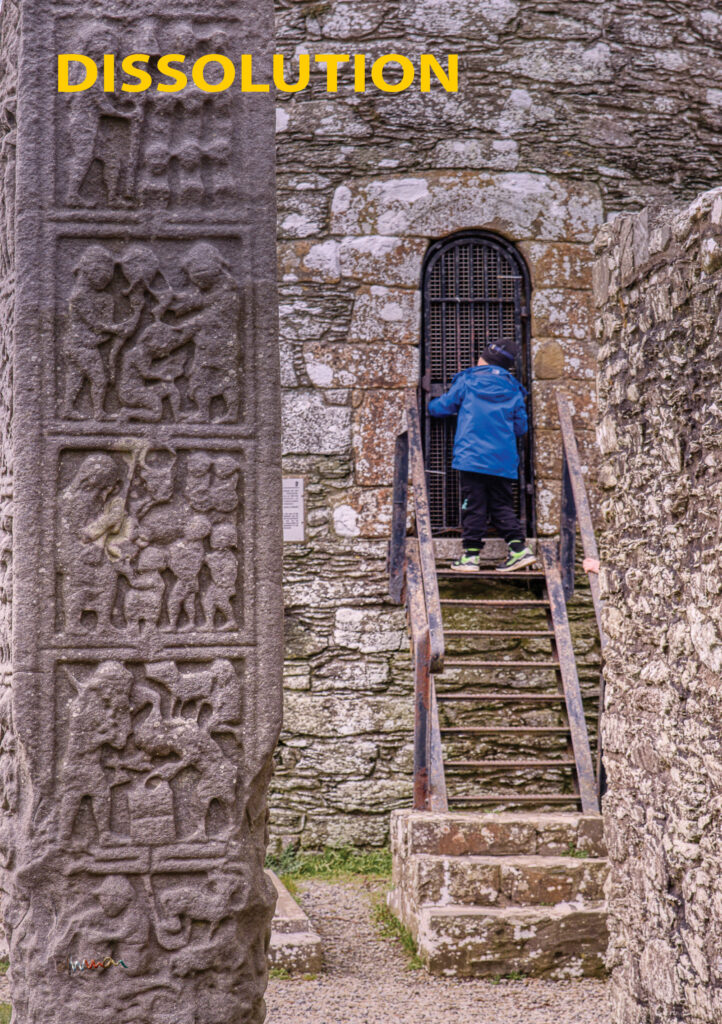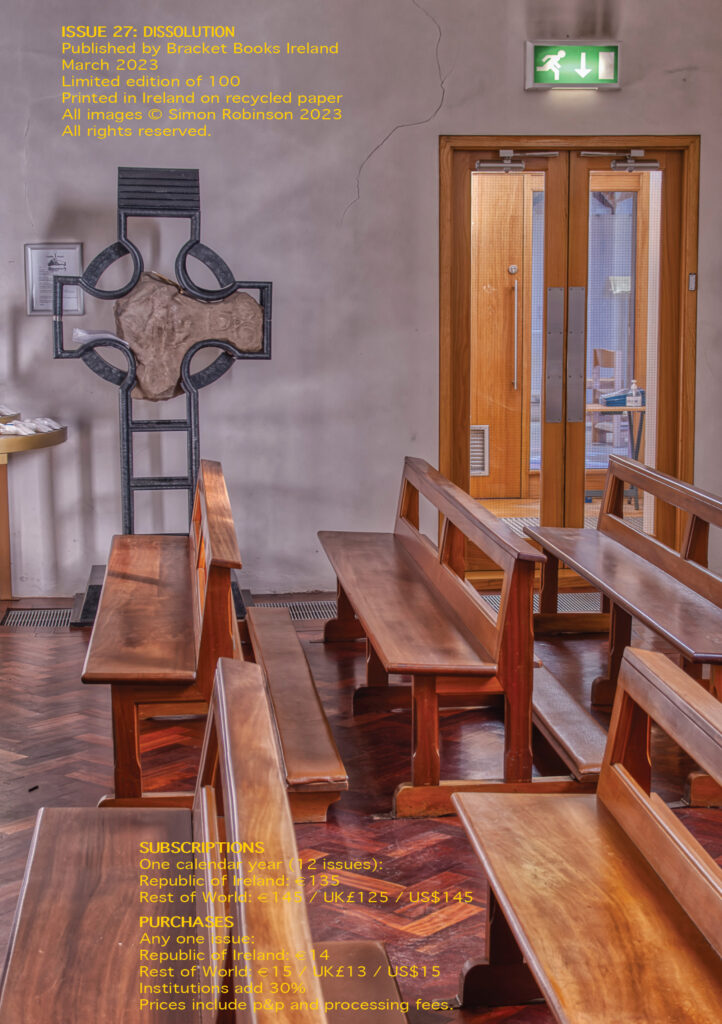The fundamentals of graph theory, the mathematical structures that model relations between paired objects, may only have been formalised recently but lattices have been recognised since humans started to trap, build and weave.


Available now from Bracket Books Ireland at outlets like FabHappy or WalkingCommentary.
Visit the online Gallery: Dissolution for background and comments about the photographs.
Ireland has been studded with High Crosses for more than a millennium. These crosses represent nodes on a network of links to Rome and Jerusalem or imperious London after the dissolution of the monasteries, when the High Crosses ended up adorning newly Protestant graveyards.
Should the wonders of the world include this web of pilgrim trails and High Crosses? They linked an island to standardised Christianity at home and by imagery, to Earth and Heaven. The Christian allusions included a better life after death, a premise that can’t be disproven, an offer that costs nothing yet earns fealty and tributes in exchange for interconnectedness. Linking to seats of power remains a double edged sword; protection comes with a price. Some see elements of the same relationship today in social media where the user is the product, a not-so-hidden cost of interconnectedness and centralised administration.
Years ago, I travelled to the Bosphorus. My first entrance into the pendentive structure of Hagia Sophia in Istanbul took me aback. The age, scale and the majesty of it emphasised the power and elitism it represents. The maths and engineering behind it reminded me that education was vital for the elite that built it. In creating such awesome edifices, the disenfranchised are both subdued yet given something to aspire to. Another double edge, just like the engineering that created mobile phones that has triggered a migration crisis; what you see becomes what you want.
As Hagia Sophia was being commissioned, some 1500 years ago, politics and religion combined in Ireland to establish elitist monasteries for contemplation and learning. Their influence is still visible in the landscape so I journeyed to the Middle Kingdom in search of continuity and interconnectedness. My arrival at monastic Monasterboice was announced from the top of the round tower in Raven-speak, an avian language little changed since the monastery was established around 500 CE. Conquest and power struggles had moved the monastery to the Kingdom of Midhe when its four High Crosses were carved and installed, sometime between 950 and 1100 CE. Gerrymandering subsequently moved it to county Louth.
The crosses have been outdoors for a millennium and vulnerable to adornments, relocations, visitor behaviour and overhanging trees. The High Crosses are made of hard sandstone and harder granite, still too soft to resist the solvents of anthropocentric pollution. Not the objects of devotion they once were, they are returning a favour. Acting like a litmus test under acid rains, they allow us another way to see how 8 billion uncooperative people are massively overspending by excessive indulgences, squandering the resources of our planet.
I am hugely indebted to Susan Connolly for guiding me around the Middle Kingdom and providing me with a copious number of books on wells, crosses and local history. I remain inspired by her poems and I must acknowledge that she also birthed the notion that dissolution was a thread worth teasing.
I should add that Valerie Packenham (RIP) started my journey. A chat over dinner about her book “Exploring Ireland’s Middle Kingdom” made me realise that there was a chapbook theme lurking in the landscape.
And to Michael Holohon for a timely email about deciphering the crosses and abstraction that helped me focus.
My background readings included:
Stone and Tree Sheltering Water – Susan Connolly / Anne-Marie Moroney (1998, Flax Mill Publications)
Irish High Crosses – Peter Harbison (1994, Boyne Valley Honey Company)
Exploring Ireland’s Middle Kingdom – Valerie Packenham (2021, Somerville Press)
The Natural Navigator – Tristan Gooley (2010, Virgin Books)
The Heartbeat of Trees – Peter Wohlleben (2019, William Collins)
The Fourth Time, We Drowned – Sally Hayden (2022, 4th Estate)
And there are the general influences like Encyclopaedia Brittanica and Wikipedia.
Leohnard Euler is credited with seeding the ideas of graph theory in 1736 but it was Paul Erdős and Alfréd Rényi whose 1959 paper formalised it.
It seems that Suzanne Simard coined the phrase “wood wide web” in 1990 to describe the intricate processes whereby plants connect via underground roots and mycorrhizal fungi. I web read that 19th-century German biologist Albert Frank coined the word “mycorrhiza” to describe the partnerships by which fungus colonises the roots of plants.
Gallery: Dissolution – background and comments about these photographs presented as a photo gallery to complement the chapbook.
The Bracket Books chapbooks are available for online purchase through FabHappy but perhaps you’d prefer to enquire here. They’re published each calendar month, each copy uniquely numbered and posted at the end of each month. Prices include packaging, delivery, all currency and inflation risks.
2023 SUBSCRIPTIONS
One calendar year (12 issues):
Republic of Ireland: €135
Rest of World: €145 / UK£125 / US$145
Any one issue:
Republic of Ireland: €14
Rest of World: €15 / UK£13 / US$15
Institutions add 30%

Leave a Reply